engine Citroen C5 2017 (RD/TD) / 2.G Owner's Guide
[x] Cancel search | Manufacturer: CITROEN, Model Year: 2017, Model line: C5, Model: Citroen C5 2017 (RD/TD) / 2.GPages: 348, PDF Size: 10.72 MB
Page 49 of 348
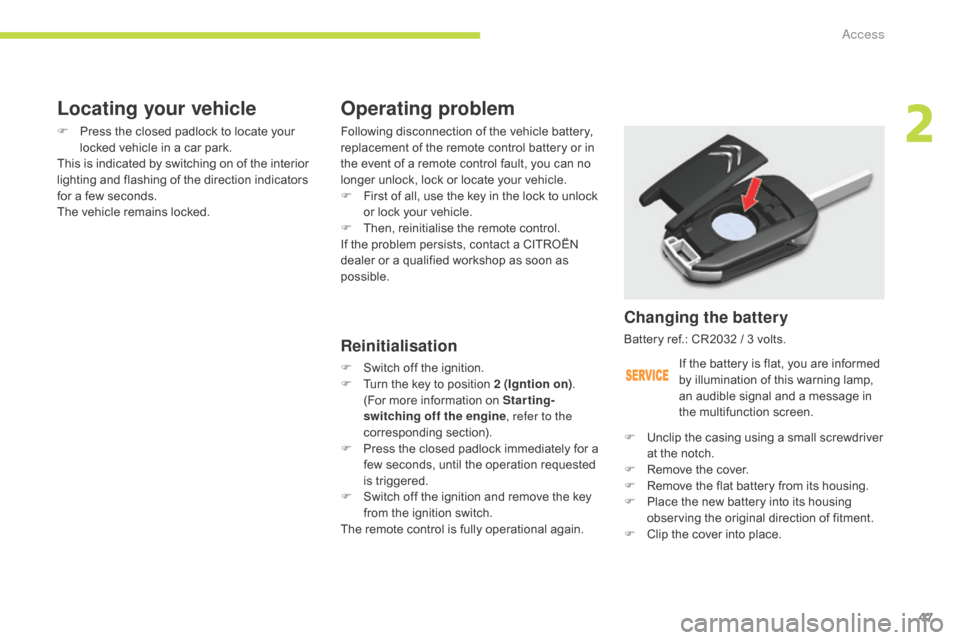
47
C5_en_Chap02_ouverture_ed01-2016
Operating problem
Following disconnection of the vehicle battery,
replacement of the remote control battery or in
the event of a remote control fault, you can no
longer unlock, lock or locate your vehicle.
F
F
irst of all, use the key in the lock to unlock
or lock your vehicle.
F
T
hen, reinitialise the remote control.
If the problem persists, contact a CITROËN
dealer or a qualified workshop as soon as
possible.
Reinitialisation
F Switch off the ignition.
F T urn the key to position 2 (Igntion on) .
(
For more information on Starting-
switching off the engine , refer to the
corresponding section).
F
P
ress the closed padlock immediately for a
few seconds, until the operation requested
is triggered.
F
S
witch off the ignition and remove the key
from the ignition switch.
The remote control is fully operational again.
Changing the battery
Battery ref.: CR2032 / 3 volts.
F
U
nclip the casing using a small screwdriver
at the notch.
F
R
emove the cover.
F
R
emove the flat battery from its housing.
F
P
lace the new battery into its housing
observing the original direction of fitment.
F
C
lip the cover into place.
Locating your vehicle
F Press the closed padlock to locate your locked vehicle in a car park.
This is indicated by switching on of the interior
lighting and flashing of the direction indicators
for a few seconds.
The vehicle remains locked.
If the battery is flat, you are informed
by illumination of this warning lamp,
an audible signal and a message in
the multifunction screen.
2
Access
Page 50 of 348
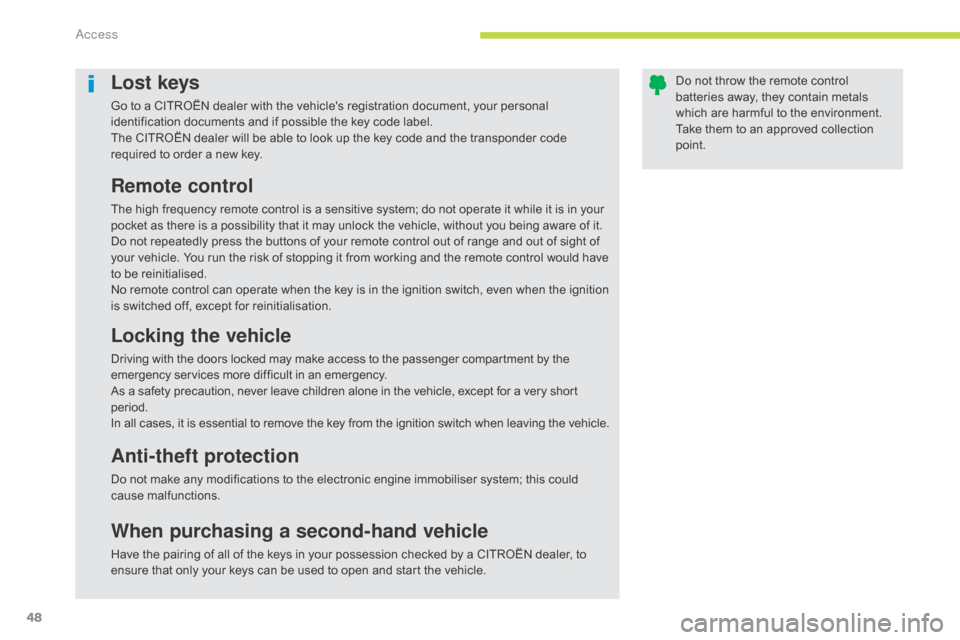
48
C5_en_Chap02_ouverture_ed01-2016
Lost keys
Go to a CITROËN dealer with the vehicle's registration document, your personal
identification documents and if possible the key code label.
The CITROËN dealer will be able to look up the key code and the transponder code
required to order a new key.
Remote control
The high frequency remote control is a sensitive system; do not operate it while it is in your
pocket as there is a possibility that it may unlock the vehicle, without you being aware of it.
Do not repeatedly press the buttons of your remote control out of range and out of sight of
your vehicle. You run the risk of stopping it from working and the remote control would have
to be reinitialised.
No remote control can operate when the key is in the ignition switch, even when the ignition
is switched off, except for reinitialisation.
Locking the vehicle
Driving with the doors locked may make access to the passenger compartment by the
emergency services more difficult in an emergency.
As a safety precaution, never leave children alone in the vehicle, except for a very short
period.
In all cases, it is essential to remove the key from the ignition switch when leaving the vehicle.
Anti-theft protection
Do not make any modifications to the electronic engine immobiliser system; this could
cause malfunctions.
When purchasing a second-hand vehicle
Have the pairing of all of the keys in your possession checked by a CITROËN dealer, to
ensure that only your keys can be used to open and start the vehicle.Do not throw the remote control
batteries away, they contain metals
which are harmful to the environment.
Take them to an approved collection
point.
Access
Page 56 of 348
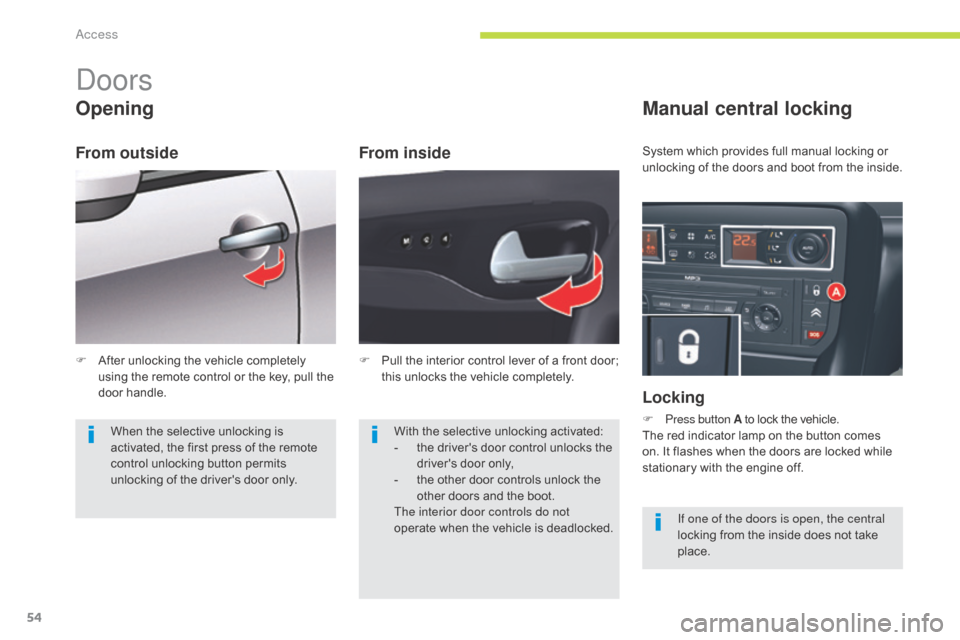
54
C5_en_Chap02_ouverture_ed01-2016
Doors
Opening
From inside
Manual central locking
Locking
F Press button A to lock the vehicle.
The red indicator lamp on the button comes
on. It flashes when the doors are locked while
stationary with the engine off.
From outside
When the selective unlocking is
activated, the first press of the remote
control unlocking button permits
unlocking of the driver's door only. With the selective unlocking activated:
-
t he driver's door control unlocks the
driver's door only,
-
t
he other door controls unlock the
other doors and the boot.
The interior door controls do not
operate when the vehicle is deadlocked. If one of the doors is open, the central
locking from the inside does not take
place.
System which provides full manual locking or
unlocking of the doors and boot from the inside.
F
A
fter unlocking the vehicle completely
using the remote control or the key, pull the
door handle. F
P
ull the interior control lever of a front door;
this unlocks the vehicle completely.
Access
Page 62 of 348
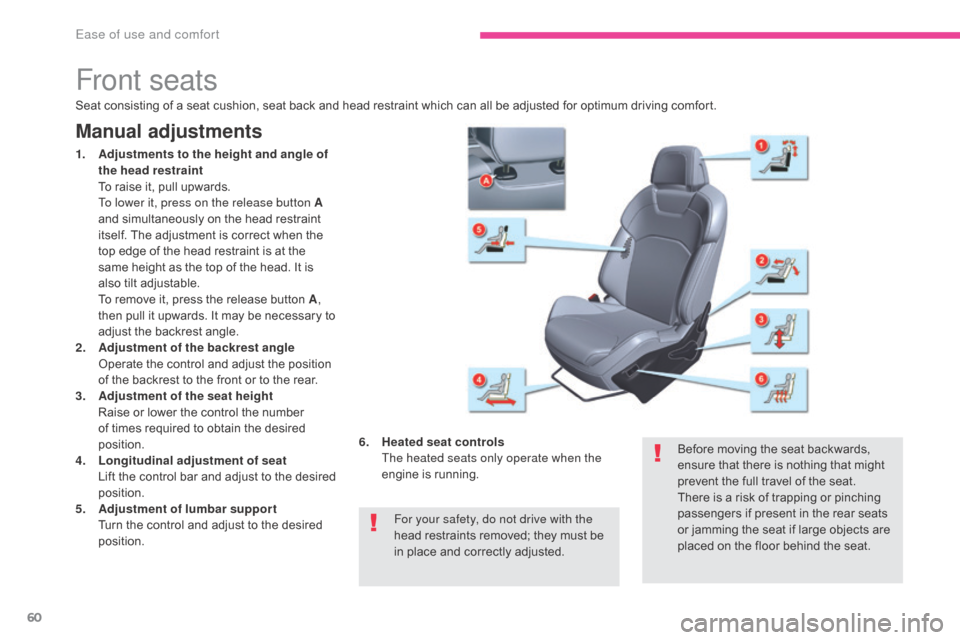
60
C5_en_Chap03_ergonomie-et-confort_ed01-2016
Front seats
Manual adjustments
1. Adjustments to the height and angle of the head restraint
T
o raise it, pull upwards.
T
o lower it, press on the release button A
and simultaneously on the head restraint
itself. The adjustment is correct when the
top edge of the head restraint is at the
same height as the top of the head. It is
also tilt adjustable.
T
o remove it, press the release button A ,
then pull it upwards. It may be necessary to
adjust the backrest angle.
2.
A
djustment of the backrest angle
O
perate the control and adjust the position
of the backrest to the front or to the rear.
3.
A
djustment of the seat height
R
aise or lower the control the number
of times required to obtain the desired
position.
4.
L
ongitudinal adjustment of seat
L
ift the control bar and adjust to the desired
position.
5.
A
djustment of lumbar support
T
urn the control and adjust to the desired
position.
Seat consisting of a seat cushion, seat back and head restraint which can all be adjusted for optimum driving comfort.
For your safety, do not drive with the
head restraints removed; they must be
in place and correctly adjusted.Before moving the seat backwards,
ensure that there is nothing that might
prevent the full travel of the seat.
There is a risk of trapping or pinching
passengers if present in the rear seats
or jamming the seat if large objects are
placed on the floor behind the seat.
6.
H
eated seat controls
T
he heated seats only operate when the
engine is running.
Ease of use and comfort
Page 63 of 348
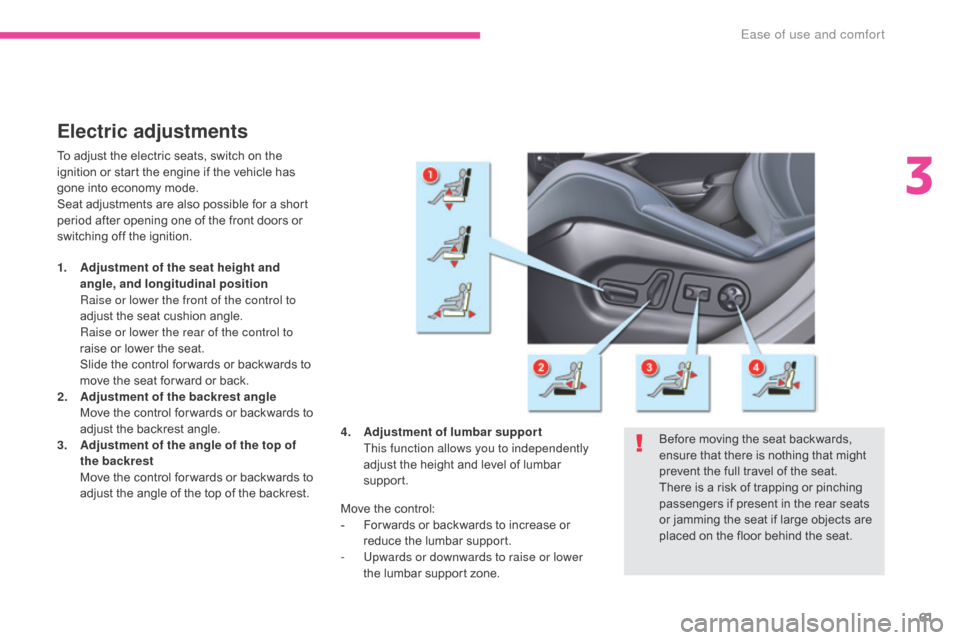
61
C5_en_Chap03_ergonomie-et-confort_ed01-2016
Electric adjustments
To adjust the electric seats, switch on the
ignition or start the engine if the vehicle has
gone into economy mode.
Seat adjustments are also possible for a short
period after opening one of the front doors or
switching off the ignition.
1.
A
djustment of the seat height and
angle, and longitudinal position
R
aise or lower the front of the control to
adjust the seat cushion angle.
R
aise or lower the rear of the control to
raise or lower the seat.
S
lide the control for wards or backwards to
move the seat for ward or back.
2.
A
djustment of the backrest angle
M
ove the control for wards or backwards to
adjust the backrest angle.
3.
A
djustment of the angle of the top of
the backrest
M
ove the control for wards or backwards to
adjust the angle of the top of the backrest. Before moving the seat backwards,
ensure that there is nothing that might
prevent the full travel of the seat.
There is a risk of trapping or pinching
passengers if present in the rear seats
or jamming the seat if large objects are
placed on the floor behind the seat.
Move the control:
-
F
or wards or backwards to increase or
reduce the lumbar support.
-
U
pwards or downwards to raise or lower
the lumbar support zone.
4.
A
djustment of lumbar support
T
his function allows you to independently
adjust the height and level of lumbar
support.
3
Ease of use and comfort
Page 64 of 348
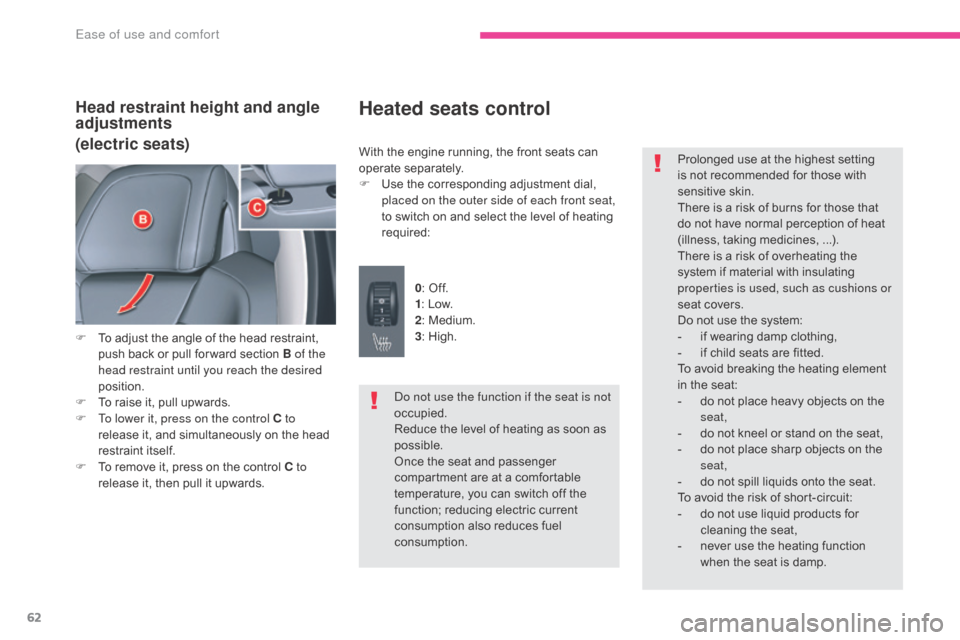
62
C5_en_Chap03_ergonomie-et-confort_ed01-2016
Head restraint height and angle
adjustments
(electric seats)
F To adjust the angle of the head restraint, push back or pull for ward section B of the
head restraint until you reach the desired
position.
F
T
o raise it, pull upwards.
F
T
o lower it, press on the control C to
release it, and simultaneously on the head
restraint itself.
F
T
o remove it, press on the control C to
release it, then pull it upwards.
Heated seats control
With the engine running, the front seats can
operate separately.
F
U
se the corresponding adjustment dial,
placed on the outer side of each front seat,
to switch on and select the level of heating
required:
0: Off.
1 : Low.
2 : Medium.
3 : High.
Do not use the function if the seat is not
occupied.
Reduce the level of heating as soon as
possible.
Once the seat and passenger
compartment are at a comfortable
temperature, you can switch off the
function; reducing electric current
consumption also reduces fuel
consumption. Prolonged use at the highest setting
is not recommended for those with
sensitive skin.
There is a risk of burns for those that
do not have normal perception of heat
(illness, taking medicines, ...).
There is a risk of overheating the
system if material with insulating
properties is used, such as cushions or
seat covers.
Do not use the system:
-
i
f wearing damp clothing,
-
i
f child seats are fitted.
To avoid breaking the heating element
in the seat:
-
d
o not place heavy objects on the
seat,
-
d
o not kneel or stand on the seat,
-
d
o not place sharp objects on the
seat,
-
d
o not spill liquids onto the seat.
To avoid the risk of short-circuit:
-
d
o not use liquid products for
cleaning the seat,
-
n
ever use the heating function
when the seat is damp.
Ease of use and comfort
Page 65 of 348

63
C5_en_Chap03_ergonomie-et-confort_ed01-2016
Welcome function
The welcome function assists entry and exit
from the vehicle.
After switching off the ignition and opening
the driver’s door, the driver's seat moves back
automatically and then stays in this position,
ready for the next entry to the vehicle.
When switching on the ignition, the seat moves
for ward to the memorised driving position.
When moving the seat, take care that no
person or object hinders the automatic
movement of the seat.
This function is deactivated by default.
You can activate or deactivate this function in
the vehicle parameters menu.
This function provides the driver with a back
massage. It only operates when the engine is
running.
F
P
ress on button A .
The warning lamp comes on and the massage
function is activated for a period of 1 hour.
During this time, massage is per formed in
cycles of 6
minutes (4 minutes of massage
followed by 2 minutes break). In total, the
system will per form 10 cycles.
After 1 hour, the function is deactivated.
The
warning lamp goes out.
Massage function
Deactivation
You can deactivate the massage function at
any time by pressing on button A .
3
Ease of use and comfort
Page 66 of 348
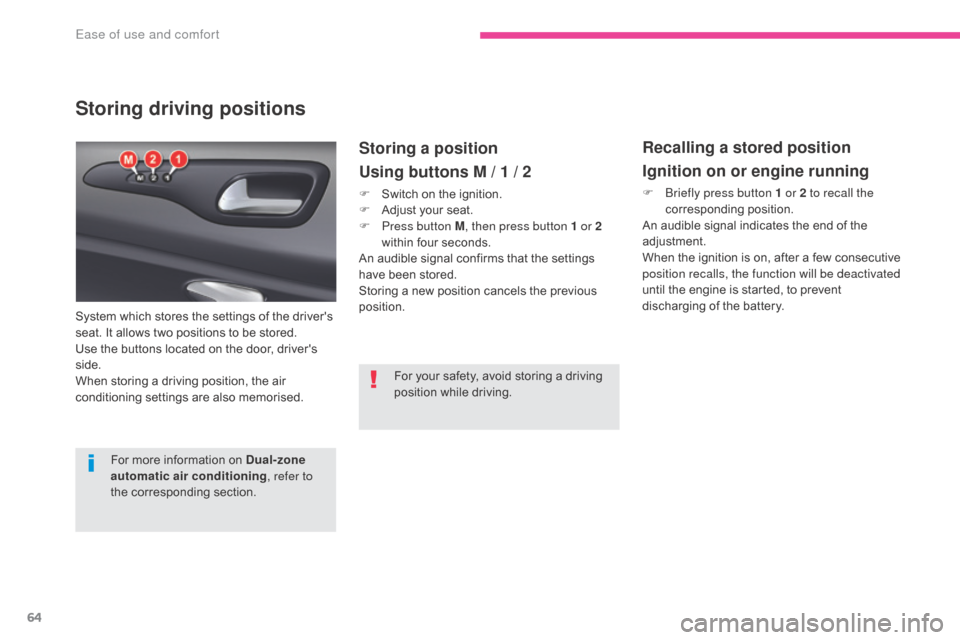
64
C5_en_Chap03_ergonomie-et-confort_ed01-2016
Storing driving positions
System which stores the settings of the driver's
seat. It allows two positions to be stored.
Use the buttons located on the door, driver's
side.
When storing a driving position, the air
conditioning settings are also memorised.
Storing a position
Using buttons M / 1 / 2
F Switch on the ignition.
F A djust your seat.
F
P
ress button M , then press button 1 or 2
within four seconds.
An audible signal confirms that the settings
have been stored.
Storing a new position cancels the previous
position.
For more information on Dual-zone
automatic air conditioning , refer to
the corresponding section. For your safety, avoid storing a driving
position while driving.
Recalling a stored position
Ignition on or engine running
F Briefly press button 1 or 2 to recall the
corresponding position.
An audible signal indicates the end of the
adjustment.
When the ignition is on, after a few consecutive
position recalls, the function will be deactivated
until the engine is started, to prevent
discharging of the battery.
Ease of use and comfort
Page 73 of 348
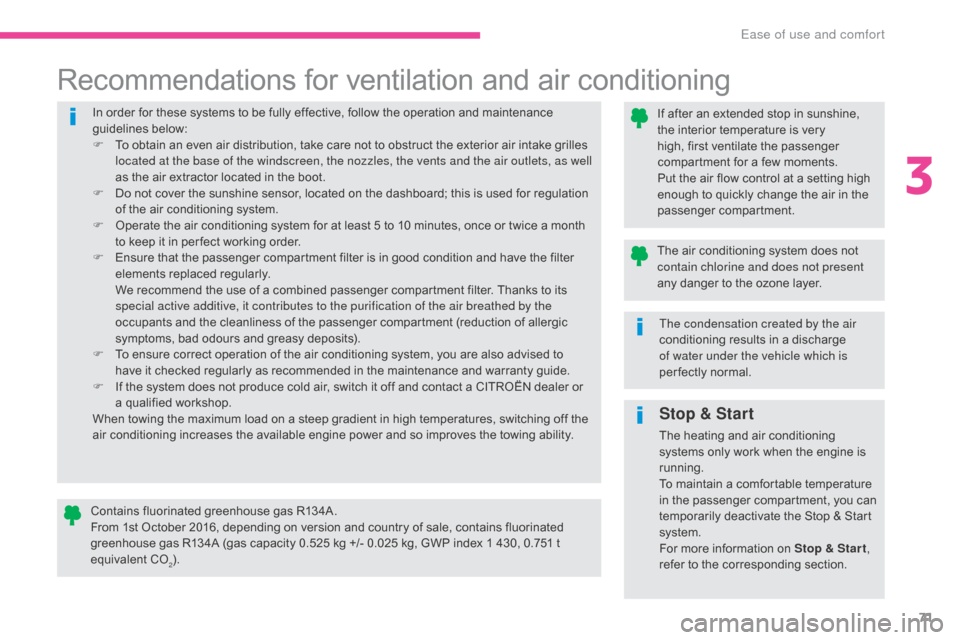
71
C5_en_Chap03_ergonomie-et-confort_ed01-2016
In order for these systems to be fully effective, follow the operation and maintenance
guidelines below:
F
T
o obtain an even air distribution, take care not to obstruct the exterior air intake grilles
located at the base of the windscreen, the nozzles, the vents and the air outlets, as well
as the air extractor located in the boot.
F
D
o not cover the sunshine sensor, located on the dashboard; this is used for regulation
of the air conditioning system.
F
O
perate the air conditioning system for at least 5 to 10 minutes, once or twice a month
to keep it in per fect working order.
F
E
nsure that the passenger compartment filter is in good condition and have the filter
elements replaced regularly.
W
e recommend the use of a combined passenger compartment filter. Thanks to its
special active additive, it contributes to the purification of the air breathed by the
occupants and the cleanliness of the passenger compartment (reduction of allergic
symptoms, bad odours and greasy deposits).
F
T
o ensure correct operation of the air conditioning system, you are also advised to
have it checked regularly as recommended in the maintenance and warranty guide.
F
I
f the system does not produce cold air, switch it off and contact a CITROËN dealer or
a qualified workshop.
When towing the maximum load on a steep gradient in high temperatures, switching off the
air conditioning increases the available engine power and so improves the towing ability.
Recommendations for ventilation and air conditioning
Stop & Start
The heating and air conditioning
systems only work when the engine is
running.
To maintain a comfortable temperature
in the passenger compartment, you can
temporarily deactivate the Stop & Start
system.
For more information on Stop & Star t ,
refer to the corresponding section. The condensation created by the air
conditioning results in a discharge
of water under the vehicle which is
per fectly normal.
If after an extended stop in sunshine,
the interior temperature is very
high, first ventilate the passenger
compartment for a few moments.
Put the air flow control at a setting high
enough to quickly change the air in the
passenger compartment.
Contains fluorinated greenhouse gas R134A.
From 1st October 2016, depending on version and country of sale, contains fluorinated
greenhouse gas R134A (gas capacity 0.525 kg +/- 0.025 kg, GWP index 1 430, 0.751 t
equivalent CO
2). The air conditioning system does not
contain chlorine and does not present
any danger to the ozone layer.
3
Ease of use and comfort
Page 74 of 348
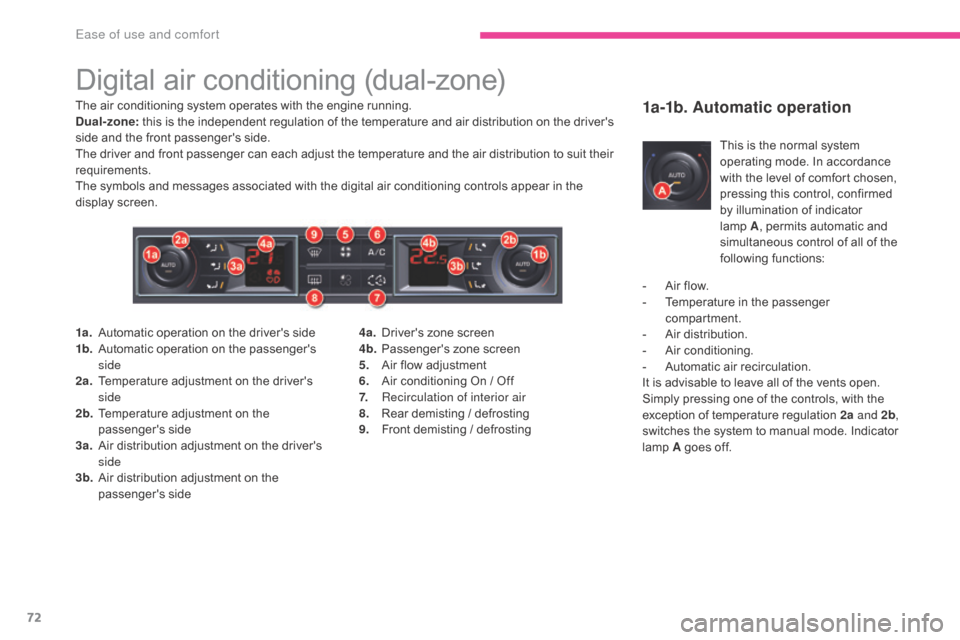
72
C5_en_Chap03_ergonomie-et-confort_ed01-2016
Digital air conditioning (dual-zone)
The air conditioning system operates with the engine running.
Dual-zone: this is the independent regulation of the temperature and air distribution on the driver's
side and the front passenger's side.
The driver and front passenger can each adjust the temperature and the air distribution to suit their
requirements.
The symbols and messages associated with the digital air conditioning controls appear in the
display screen. This is the normal system
operating mode. In accordance
with the level of comfort chosen,
pressing this control, confirmed
by illumination of indicator
lamp
A, permits automatic and
simultaneous control of all of the
following functions:1a-1b. Automatic operation
1a. Automatic operation on the driver's side
1b. A utomatic operation on the passenger's
side
2a.
T
emperature adjustment on the driver's
side
2b.
T
emperature adjustment on the
passenger's side
3a.
A
ir distribution adjustment on the driver's
side
3b.
A
ir distribution adjustment on the
passenger's side 4a. D
river's zone screen
4b. P assenger's zone screen
5.
A
ir flow adjustment
6.
A
ir conditioning On / Off
7.
R
ecirculation of interior air
8.
R
ear demisting / defrosting
9.
F
ront demisting / defrosting-
A
ir flow.
-
T
emperature in the passenger
compartment.
- A ir distribution.
-
A
ir conditioning.
-
A
utomatic air recirculation.
It is advisable to leave all of the vents open.
Simply pressing one of the controls, with the
exception of temperature regulation 2a and 2b,
switches the system to manual mode. Indicator
lamp A goes off.
Ease of use and comfort